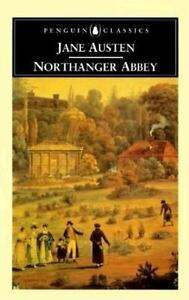Northanger Abbey
Jane Austen
Penguin, 1995 (originally published 1817)
231 pages
I think this is my first Jane Austen novel! Hard to believe, I know, but it just never came up; not in high school and not as a chemistry major in college. This was the first novel written by Austen, apparently around 1799, although it wasn't published until after her death in 1817.
"Northanger Abbey" is divided into two nearly equal parts, 98 &103 pages. In part 1 our heroine, Catherine, is introduced as a sweet, unworldly girl from a country village who is introduced to high society in Bath, England, sometime during the early part of the Regency period, which lasted from 1790 to 1820. Fashionistas from all over England travelled to Bath to see and be seen, in addition to drinking the famous curative waters. We follow Catherine as she takes in the scene and meets some new friends.
In part 2 Catherine visits some people she has met in Bath, Eleanor and Henry Tilney, at their father's estate in Gloucestershire, Northanger Abbey. Having read numerous gothic romance novels, popular in the late 1700s, Catherine lets her imagination run away with her at the abbey. Creepy sounds, dark passageways, seemingly odd events, a dead wife, all bring her terror, sleepless nights, and misery. Never fear, there is a happy ending!
I was not fond of this book. I know it's satire and things are overblown on purpose, but it was a bit boring. I did not like the writing style, either; it seemed a bit too coy. Austen herself lived in Bath from 1801 to 1806 and her contemporary account of what Bath was like during the Regency Period was very enjoyable, though. I knew that people visited the Pump Room to drink the waters, and that there were festive gatherings, but I didn't understand how it all worked before reading this.
This is my entry for the Back to the Classics 2019 Challenge, in the Nineteenth Century Classic category.
FURTHER READING
Jane Austen's World
"This Jane Austen blog brings Jane Austen, her novels, and the Regency Period alive through food, dress, social customs, and other 19th C. historical details related to this topic."
https://janeaustensworld.wordpress.com/tag/regency-bath/
Subscribe to:
Post Comments (Atom)
-
Book Beginnings is a weekly meme hosted by Rose City Reader . We share the first sentence (or so) of the book we are reading, along with o...
-
Every Frenchman Has One Olivia de Havilland Penguin Random House, 2016 143 pages This is an amusing little book of short pieces by Olivia de...
-
Red Pottage Mary Cholmondeley Amazon Digital Services, 2012 originally published by Edward Arnold, 1899 252 pages in the paperback versi...




No comments:
Post a Comment